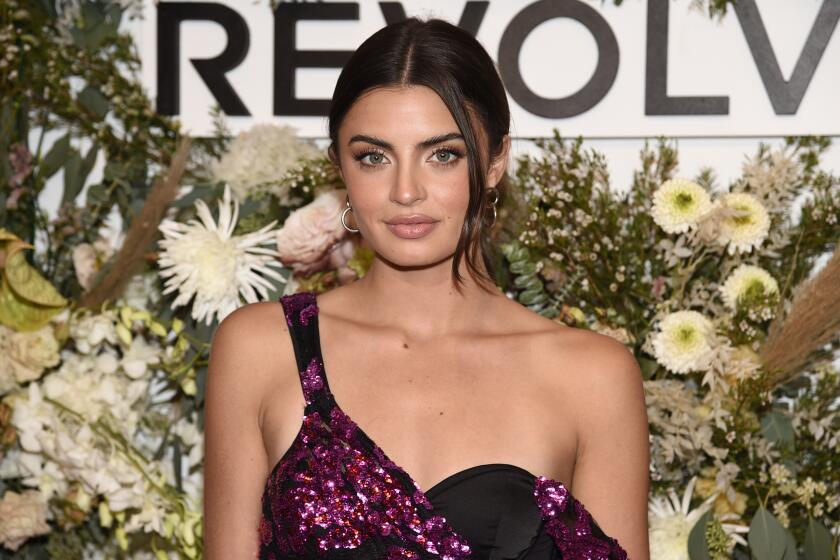Romeo and ... what’s her name
- Share via
Rollando VILLAZON is a white-hot Romeo. The electricity this zealous young Mexican tenor generates noticeably excited just about everyone in the Dorothy Chandler Pavilion on Saturday night. Everyone, that is, except Juliet.
But then, Anna Netrebko, the glamorous Russian soprano, had other things to worry about, such as competing with Romeo and exciting the audience herself. The opera world’s two most hyped young singers have come to town for a new Los Angeles Opera production of Charles Gounod’s “Romeo and Juliet.”
It was Gounod’s job to make Shakespeare conform to the 19th century Parisian conventions of grand opera, such as where to place the ballet (well along so the big-shot latecomers won’t miss it). It is now Villazon and Netrebko’s job not to make us care what Gounod did.
The result is a mess. Ian Judge’s production, which hopes to turn Gounod’s theatrical effects into theater, somehow manages to be simultaneously gaudy and lackluster. And while there isn’t a lot of scenery in the skeletal set for the ravenously hungry-for-success pair of lovers to chew, chew they do as if they haven’t had an operatic meal in ages.
But Villazon has arrived. And nothing -- not a languorous opera, witless stage direction, annoying set, dull supporting cast, crude conducting -- can stop him. Watching him transcend every musical, dramatic and scenic obstacle thrown in his path, including that of an essential lack of chemistry between the lovers, proved not only weirdly fascinating but downright inspiring.
Villazon’s irrepressible ardor as Romeo has two sides to it: boyish innocence and anger. He is immediately striking for his exceptionally wide eyes and wide mouth. The eyes enthusiastically drink in everything around him; the mouth releases, in a magnificent stream of stirring high notes, everything inside him.
He is, thus, a Romeo easily thrilled and just as easily outraged. His love of life is infectious. There is an immediacy to everything he does, whether it is leaping in bed with Juliet, lunging at Tybalt in murderous rage or bounding into the next soaring musical phrase. The effect is of a continual reaching out. Even in his dying, he reaches for Juliet as she lies on her tomb, his arm outstretched to hers like Adam’s in Michelangelo’s Sistine Chapel.
He doesn’t, here, quite make it, dying before he can touch her. And that turns out to be a perhaps unintentional symbolic touch on Judge’s part. Villazon and Netrebko are being touted as a particularly salable new operatic couple, a joy to look at and a joy to hear. But Netrebko is on such a fast track to stardom that she has come to seem completely self-absorbed in her swanlike beauty. There was little spontaneity in her performance, little sense that she was singing to anyone onstage.
She is, of course, dazzling, physically and vocally, and much of this production appeared designed to show her off. John Gunter’s industrial set -- movable cages with staircases -- did nothing to take attention away from the star singers. Tim Goodchild’s gowns for the women were lavish, and those for Netrebko spectacular. Nigel Levings’ lighting was her adoring spotlight.
But all of this only made Netrebko look more doll-like. She did plenty of acting, elegantly polished in the Jewel Song in the first act, nearly demented by the end. Vocally, she took a while to warm up, but her voice found its creamy center. Dramatically, though, the performance never really jelled. She lost considerable credibility when her love scene in bed with Romeo was played for eroticism but got laughs instead.
What could Judge have been thinking here? Had he hoped for some real lust in this formulaic opera?
Gounod could write a fugue. He could write a tune. He could write boisterous music for the big fight scene (in which Judge had his best moment). But there are so many long stretches of uninspired music, and the love scene is one of them. The very act of trying to find something more through staging only emphasizes the opera’s conventionality.
The performance did feature a few nice character touches in the supporting cast, most notably from Suzanna Guzman, as Juliet’s nurse, and Anna-Maria Panzarella, who prettily sang Stephano’s song about a turtledove. Reinhard Hagen brought rare understatement and eloquence to Friar Lawrence. Simone Alberghini’s nasal Lord Capulet emphasized his unpleasant character. The various Capulets and Montagues carried on as Capulets and Montagues always do.
The conductor, Frederic Chaslin, drew more coarse playing from the orchestra than has become common of late, even though the performance was dedicated to the memory of principal clarinetist Emily Bernstein, who died last week. The chorus sang dutifully.
But few Saturday cared about the dutiful. The moment the curtain came down, then rose on the embracing lovers, the whole audience was on its feet, and throughout the curtain calls, Villazon practically levitated. A great new singer, and a great new force, is in our midst. I hope next time around L.A. Opera gives him something really worthwhile to do.
*
‘Romeo and Juliet’
Where: Los Angeles Opera at the Dorothy Chandler Pavilion, 135 N. Grand Ave., L.A.
When: 7:30 p.m. Thursday, Feb. 9, 12 and 17; 2 p.m. Sunday and Feb. 20
Price: $25 to $190
Contact: (213) 972-8001 or www.losangelesopera.com
More to Read
The biggest entertainment stories
Get our big stories about Hollywood, film, television, music, arts, culture and more right in your inbox as soon as they publish.
You may occasionally receive promotional content from the Los Angeles Times.











